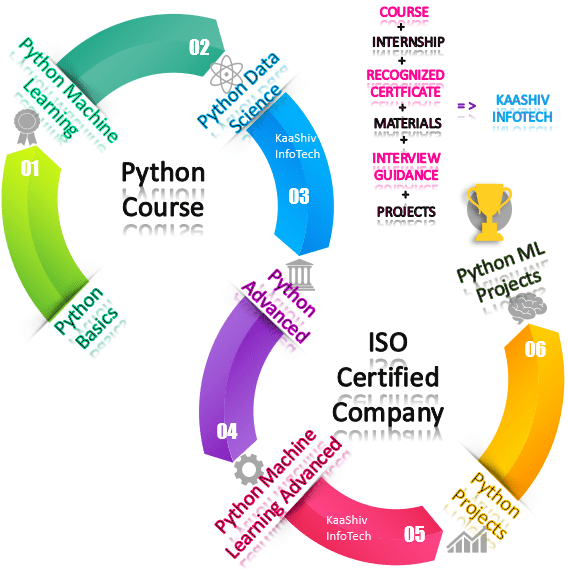

ISO Certified Company - Google Rated Number 1
Python training in chennai
KaaShiv Infotech offers, python training in chennai . Our, python course in chennai – provides you an in-depth knowledge on Python Programming. This python training enables the students to understand and learn the current trend in the job market. Students will prefer to trainings build their profile for their jobs and also for their higher studies. Our company provides both offline and online courses for python. python classes in chennai – imparts technical and programming skills on the below list of python areas such as,
- Python Basics – Python Programming, Python Installation
- Python Operations – How to use python
- Python Machine Learning – Machine learning with Python Programming , Algorithms& its implementation
- Python Data Science – Data Science with Python Programming , Algorithms& its implementation
- Python Advanced – OOPS , Class / Object python programs , Exception Handling in python
- Python Project – Step by step procedure in implementing python programming
Highlights of our company
- Common Wealth Bank Recognized Leading Light Rising Star Award Winner
- Run by 10 Years Microsoft Awarded MVP ( Most Valuable Professional )
- Google Recognized Experts and Cisco Recognized Certified Experts
- Microsoft Certified Professionals
- Artificial Intelligence and Robotics Experts
- HCL Technologies Awarded SME ( Subject Matter Expert )
data science training in chennai
Why our company provides, python certification in chennai
The Course curriculum for, python trainers – is carefully researched and prepared by professionals from MNC to meet the demands expected in the current IT industries. After completing the course at KaaShiv Infotech, students will be familiar with the entire python programming, Machine learning concepts with python, Data science with python, Implementing a python project. Below are some of the insights of our programme, python training chennai ,
Trainers to train you
Our, python training in porur chennai – Program Trainers are real-time IT experts and professionals worked in python programming from leading MNCs like
- TCS,
- HCL,
- Infosys,
- Cognizant,
- Wipro



Benefits of Doing an, python classroom training
What is python course ? Student can get a real world experience and also our company provides a hands on training in a professional environment. Courses help to getting a chance to try all the possible jobs with exploring different options in career.
- A chance to develop your knowledge and skills in a particular field or industry
- Exploring different roles to see which one you would like to pursue
- Getting insight into the way businesses work and what challenges they face on a daily basis
- Gaining valuable work experience to set you apart from other candidates
- Applying the concepts and strategies of academic study in a live work environment
- python training jobs – Most of the students will be getting ready for campus placement or off campus interviews. Applying basic theoretical ideas into the real world via training programmes horne their skills to the next level of industrial knowledge.

Career Opportunity for python classes in chennai anna nagar
- Data Analyst
- Data Scientist
- PYTHON – Technical Director
- PYTHON Application Designer / Internet of Things
- Research Analyst
- Web Development Engineer – Python Team
- Senior Software Engineer
- Python Developer
KaaShiv Infotech’s Course Training Programme molds your skills based on the above-mentioned technologies and places you in dream job roles from essentials to Advanced.
Python Training provides a real time exposure for the students on the latest and trending technologies in the software companies.
What is Python ? - Basic Introduction on Python
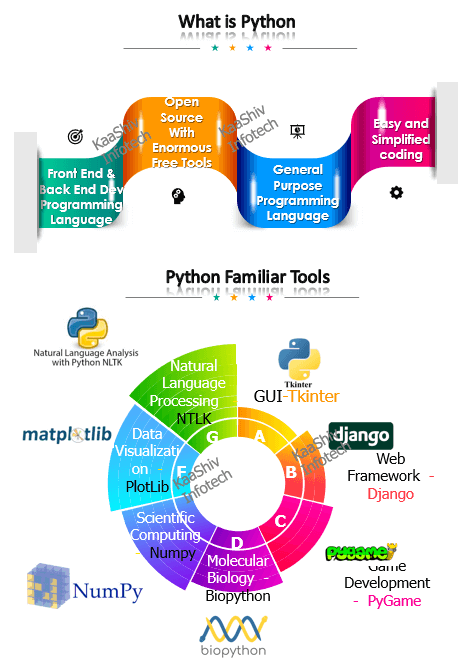
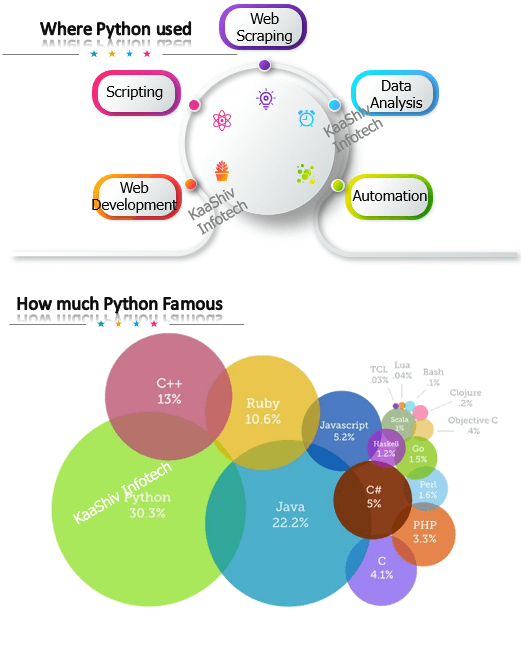
Learn and Implement
70 to 400 Concepts Covering 9 Technologies
+ 1 Projects
Python Course Structure
- Python Course – Duration: Week Day / Week End – Any Day Any Time – Students can come and study
- Training hours: 50 hrs
- Software & other tools installation Guidance
- Hardware support
- Python Course Materials creation / Python Project Report creation
- KaaShiv Infotech is top under, python coaching centre near me , based 1 real time projects – After 6 months of regular Paid course, Course becomes free + For best interns Stipend will be provided + Best Interns will be offered Job too.
- Certificates will be given
- Course Completion Certificate
- Industrial exposure certificate
- + ( Achievement certificate for best performers )


S.No |
python classes in chennai 100% Practical – Live HandsOn – Course for python programmers |
|---|---|
| Topic 1 : | Python Programming – Introduction History of Technology , Evolution of Programming Languages , What is python , History of Python , Why Python , Where Python used for? , Big Companies Using python , Tools and Frameworks In Python , How Python code works , Python for .Net and Java , DOWNLOAD & INSTALL PYTHON , Domain Vs Tools in Python , Install Python ,Python Tool – How to work |
| Topic 2 : | Python Operations – Basics
Strings in Python , Integer in Python , Operators in Python , String Operations in Python , Loops in Python , Not in and In Operator in Python , Lists – Advanced functions in Python |
| Topic 3 : | Python Matrix and Python Functions
Matrix Operations , Matrix Usages , Functions with arguments and Parameters, Advanced functions and Advanced concepts |
| Topic 4 : | Python Advanced 1
What is Class & Object , What is Constructor , What is Inheritance , What is self method , Try except , Raise exception |
| Topic 5 : | Python Project
IOT, Step by step guidance on, python internship projects , Project Implementation , Project report creation |
| Topic 6 : | Python Machine Learning Creating a Data Frame , Transform Values to Numbers , Data Mappers , Null Finding , Null Mapping to Mean Value , Null Mapping to Constant Value , Accessing Inbuilt Data Sets , Finding Outlier Data , Filter Missing Values , Feature Selection |
| Topic 7 : | Python Data Science What is Data Science , Diff between DS, Data Analysis, Data Mining , Data Mining Vs Data Science , History of Data Science , What does a data Scientist will do , Data Science – Life Cycle , Data Science – Step by Step , How Data Science works , Data Science – Mean Implementation , Data Science – Probability Implementation |
| Topic 8 : | Python Machine Learning Advanced Datasets for Research , Access Datasets and How to convert into Data Frame ? , Dataset Details , What are we going to See in this Session ? , What is LDA , Why LDA Technique , How LDA Technique Waorks ? , LDA Implementation Possibilities , Feature Filtration using Threshold Technique , How to Calculate Variance ? , Model Evaluation , Intelligence learning Systems , Basic Datasets to do research , Planned Procedure to achieve our result , Planned data for our research , Machine Learning & Data Science Algorithms , Unsupervised Learning , Supervised Learning , Clustering Vs Classification , Dataset Details , Sample Datasets For Clustering , Sample Datasets For Classification , Sample Datasets For Regression , Clustering , Classification , Regression |
| Topic 9 : | Python Tkinter GUI Programming Basic Intro On Application Vs Database , How Sqlite Works , Who Is Using Sqlite , How To Work With Python And Sqlite , Python Gui Programming – Tkinter , How Tkinter Program Works , Labels In Tkinter , Grids In Tkinter , Button In Tkinter , Button Click In Tkinter , Combo Box In Tkinter , Check Box In Tkinter , Radio Btn In Tkinter , Introduction To Mysql , How To Work With Python And Mysql |
+ Course Completion Certificate
+ Free Industrial exposure certificate + (Achievement certificate for best performers) + 1 Python Projects
machine learning training in chennai
Apply for course - Contact Us
Contact Number / Whatsapp Number
Mobile 2 : 7667664842
Mobile 3 : 9840678906

data science training in chennai
Sample Video – python training in chennai
python training and Course – Demo Link :
Check out our Sample Content under the topics ” python training in chennai”
Check our Previous testimonials from students from Different Countries and Different States :
Check our students, Course feedback kaashiv infotech reviews
More about our Company
Python inplant training
Our, python training in chennai - Training Youtube Channels –
Our Technology Channel :
https://www.youtube.com/channel/UC2MYZHG8a56u4REI2RedtRA
Our Subject Channel :
https://www.youtube.com/channel/UC9dcBYLL-ZGTy7ml8YMTlag/videos
Check out the colleges attended our Course :
Click to view more details python training in chennai
Intern Students Feedback
Check our ( Intern )Students Feedback :
Inplant training in chennai for python – Feedback – https://www.kaashivinfotech.com/inplant-training-feedback
python Course – Feedback – interns for python students
Our Live Project:
We ranked Top 2000 technological companies in India, www.wikitechy.com

YEARS OF EXPERIENCE COMPANY

PROFESSIONAL EXPERTS
/ TRAINERS

SUCCESSFUL COMPLETED STUDENTS

COLLEGE
STUDENTS
PARTICIPATED
1. Materials for the Course will be provided after the completion of the programme.
2. Regular tech updates to the students.
3. Free Course Projects given
1. Industry Recognized, certificate for course will be given.
2. Certificates will be given ( Course Completion Certificate & Industrial exposure certificate ) + (Achievement certificate for best performers)
2 day / 3/ 4 / 5 / 10, 20 days or 1 month to 6 Months ( Any Number of Days – Based on student preferences)
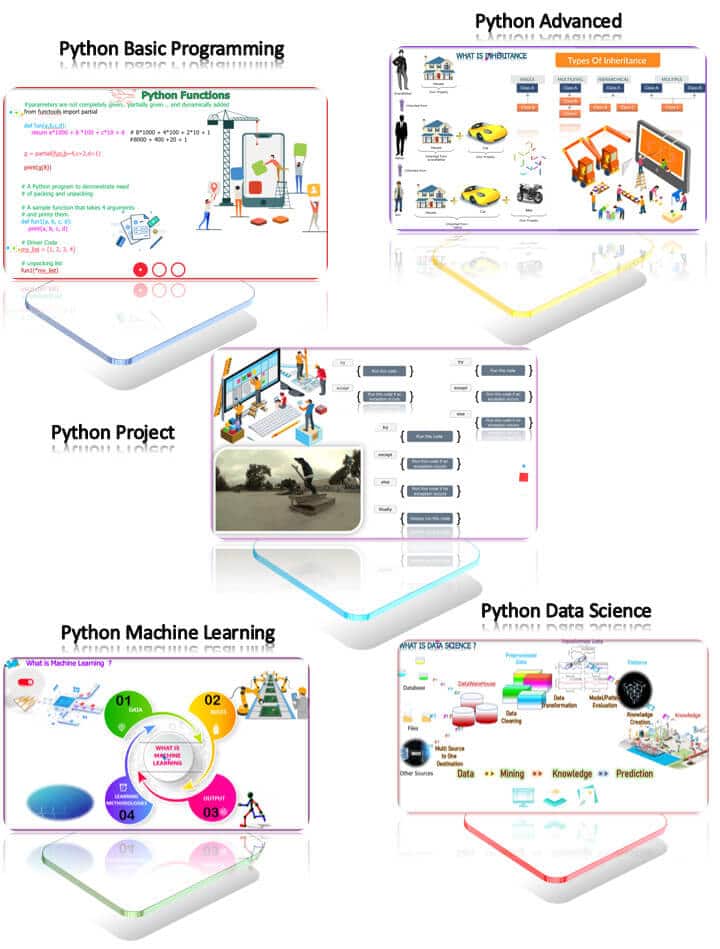
Specialized technologies from, python institute
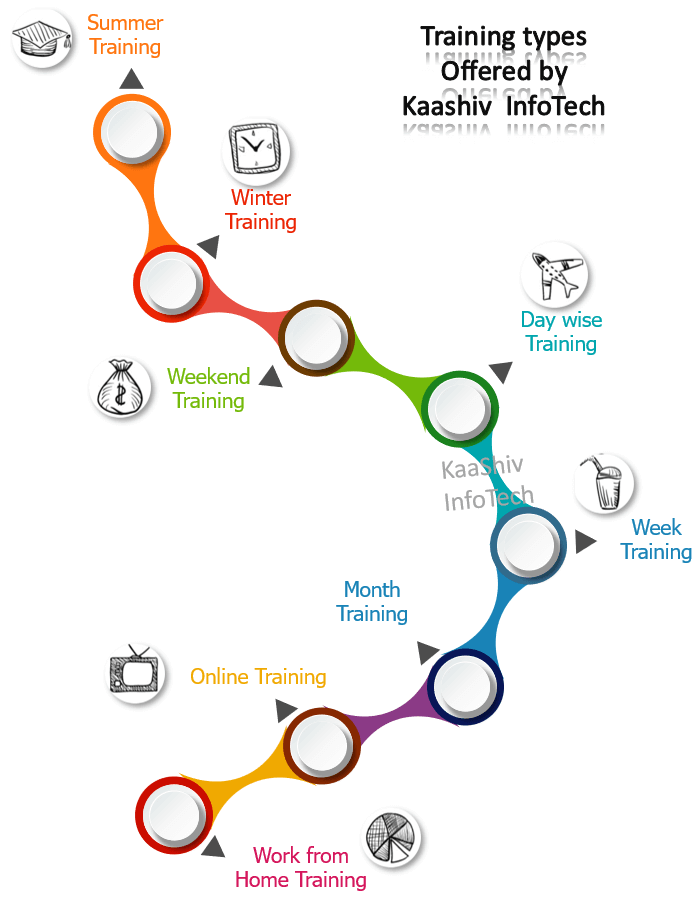
python course in chennai fees
python course online
python training for freshers / python training for students
- python training for freshers – This training can be done by the freshers to build their career. This programme will provide a clear baseline for the entry level engineers to enter into the IT industry.
- Before entering into the companies, doing training will give you more clarity in the programming field.
- Kaashiv Infotech recommends all department students, fresher and even school students to take up this training and build their career.
python summer training
- python summer training – This programme becomes mandatory before completing their degree for computer science based students Due to its huge involvement and implementation flexibility in many fields. Python becomes a universal language for all.
- The reason for doing python training is, real time industrial exposure is preferred by most of the companies in India. Identifying real time training with a recognized course certificate is very important. After completing the Python training will acquire practical knowledge, analytical skills, programming skills and problem-solving skills.
python winter training
- python winter training – Python training can be done by diploma studying students , engineering students or freshers and arts college students too.
- Students can prefer the trainings in the winter holidays too. Doing a meaningful learning in the holidays is the best and first step towards the vision of success. The reason is, your career is getting enhanced and Practical knowledge with programming skills carves the python interns towards cutting edge technologies. Working as a python intern will help them to achieve the same.
Online python training
- kaashiv offers online python training – for the students or professionals who prefer, python training work from home .
- Python training will be learning cutting edge technology based out of python with online classes for python . Our, training in python online – programme provides Online portal to study anytime, online classes to study flexibly , industry recognized certificate with, python interview questions for all the attendees. python training work – can be preferred from different locations such as, python training chennai (or) python training in chennai preferred students can learn online and can come down to office to learn and resolve your doubts directly from the trainers.
Python course details
PYTHON Course, provides a practical exposure for the students on the latest and trending technologies. some of the Top jobs in the IT Industry are
- Web Development Engineer – Python Team
- Senior Software Engineer
- Python Developer
- PYTHON – Technical Director
- PYTHON Application Designer / Internet of Things
- Research Analyst
- Data Analyst
- Data Scientist
python course duration and fees (or) python course duration and fees – 10 hours / 50 hours / Or Any number of days (based on your student preference )
Our, Python course program – provides an in-depth knowledge on basics to advanced and satisfies the students who are looking for ” python course near me ” and also ” python courses near me ”
- Course Materials will be provided for the students after the Course program
- Technological guidance and materials will be shared in the entire year for the students to mold technically.
python course fee (or) python course fees – Kaashiv infotech offering Python course follow their fee structure, and thus fees charged for completing the certification course vary from another company. If you want to know about python course details and fees , you can visit our kaashiv infotech company directly.
python course in chennai
More Question on python ( python coaching classes near me )
What are some good places to learn Python in Chennai ?
Kaashiv Infotech is the best place to learn Python training in Chennai where the training’s are provided with real time example.
The Python training in Chennai Syllabus is designed according to the student needs of the corporate client which will definitely help you to clear the interviews easily.
Which company is best for a Python course in Chennai ?
Python is a popular high-level programming language. It has advanced data structures and the OOPs concept with a simple syntax. It is mainly used as the best programming language to learn. Python is an accurate fast, easy-to-use, and easy-to-deploy programming language that is being used to develop scalable web applications.
Kaashiv Infotech is one of the best company for a Python course in Chennai. It is a great option for both beginners and experienced professionals.
How should I start learning Python ?
The right choice by starting to learn Python because Python is the world’s fastest and most popular programming language not just among SDE’s but also among Mathematicians, Data Analysts, Scientists and even Kids too. The reason is simple because Python is a very user-friendly programming language. Python has the following applications such as data analysis, Artificial intelligence , Maching learning , Automation , Build web Apps and software testing .
What shall be the mode of payment of fees ?
python course fees – Applicants shall receive an email with details about payment after completing registration by filing the registration form.
Can I get a course in data science if I have knowledge of Python ?
The Answer is, Yes . Data science course involves python programming and r programming training
Which is the best training institute for a Python certification in chennai ?
Python programming is the best career option for the students. Nowadays companies are in great demand for python developers. As new startups launched and increased in the work of web development, the use of python increased. After learning, python certification course near me – there are multiple job roles available.
In order to get the best training company, there are many good companies like Kaashiv infotech that focus more on the programming part of the students.
The training center (or) python coaching near me – center , trains students with live working on the project.
Who is my trainer and how they are selected ?
- Our trainers are more than 10+ years of experience in course relevant technologies.
- Trainers are expert level in the subjects they explain because they continue to spend time working on real-world industry applications.
- Trainers have skilled on real-time projects in their industries.
- Are working professionals working in international companies such as CTS, TCS, HCL Technologies, etc…
- Trained more than 1500+ students in a year.
- Strong theoretical & practical knowledge.
What certification will I get after Python Training ?
Each student will be given industry-recognized course completion certificate.
Is there an online training which is available for this course ?
- Yes. We provide online training programs as well. Timing is completely selected basis the availability of the candidate. Hence very flexible and comfortable.
Is doing training in Python Development worth it? Can it add some advantage to my resume for campus placement ?
The Answer is, Yes . Training in python provides lot of technological and programming knowledge to the students and enable them to become professional experts
Should I learn Java or Python ?
If you’re interested in programming, you can learn Python for its easier to learn syntax. If you plan to study computer science/engineering, I would like to recommend Java first because it helps you understand the inner workings of programming as well.
Who can apply for this Python course ?
- Students belonging to 1st year, 2nd year, 3rd year and 4th year Electronics, Instrumentation, Electronics and Telecommunications and Biomedical engineering can apply for this machine learning course.
- Students from Computer science Engineering or Information Technology Engineering can also apply for this course.
How to get python training ?
The answer is – Kaashiv infotech provides, training in python . This Course involves, learning and developing appliclations. Various technology Courses are,
Python Interview Questions and Answers
1 ) What is Python ?
- Python is a programming language with objects, modules, threads, exceptions and automatic memory management.
- It is a simple yet powerful programming language.
- It can run equally on different platforms such as Windows, Linux, UNIX, Macintosh etc. Thus, Python is a portable language.
2 ) What is Django ?
- Django is a web framework in python to develop a web application in python
3 ) What is PEP 8 ?
- PEP stands for Python Enhancement Proposal.
- It is a set of rules that specify how to format Python code for maximum readability
4 ) What are the benefits using python ?
- The benefits of python are mentioned below;
- Simple and easy,
- Portable,
- Extensible,
- Build-in data structure and
- Open source.
5 ) Can you develop software prototypes ?
- Yes, you can develop software prototypes using python like Numpy module.
6 ) What is the purpose of is, not and in operators ?
- Operators are special functions. They take one or more values and produce a corresponding result.
- is: returns true when 2 operands are true (Example: “a” is ‘a’)
- not: returns the inverse of the boolean value
- in: checks if some element is present in some sequence
7 ) What are functions in Python ?
- A function is a block of code which is executed only when it is called.
- To define a Python function, the def keyword is used.
8 ) How to avoid overload constructors or methods in Python ?
- The Python’s constructor _init_() is the first method of a class.
- We can try to instantiate an object _init_() is automatically invoked by python to initialize members of an object.
9 ) What kind of sequences is supported by Python ?
- The Python supports 7 sequences, types. They are mentioned as follows;
- str,
- list,
- tuple,
- unicode,
- byte array,
- xrange, and
- buffer.
10 ) What are an ODBC and Python ?
- DBC stands for Open Database Connectivity.
- It is the API standard that allows the connections with the database supporting the interface as a PostreSQL database or Microsoft Access.
- There are 3 ODBC modules for Python 1) PythonWin ODBC module 2) MxODBC 3) pyodbc
11 ) What is the command used for existing help window or for helping command prompt ?
- The command used for existing the help window is the quit command.
- The python shell prompt will appear by closing the help window automatically.
12 ) How is memory managed in python ?
- Memory management in Python involves a private heap containing all Python objects and data structures. Interpreter takes care of Python heap and that the programmer has no access to it.
- The allocation of heap space for Python objects is done by Python memory manager. The core API of Python provides some tools for the programmer to code reliable and more robust program.
- Python also has a build-in garbage collector which recycles all the unused memory. When an object is no longer referenced by the program, the heap space it occupies can be freed. The garbage collector determines objects which are no longer referenced by the program frees the occupied memory and make it available to the heap space.
13 ) How python is interpreted ?
- Python program runs directly from the source code.
- Each type Python programs are executed code is required.
- Python converts source code written by the programmer into intermediate language which is again translated it into the native language / machine language that is executed.
- So Python is an Interpreted language.
14 ) Who was the founder of Python and when was it released ?
- Guido Van Rossum has founded the Python and
- It was released in December 1989
15 ) What is generator in Python ?
- In Python, generator is a way that specifies how to implement iterators.
- It is a normal function except that it yields expression in the function.
16 ) What is slicing in Python ?
- Slicing is a mechanism used to select a range of items from sequence type like list, tuple, string etc
17 ) What are the advantages of Python ?
- Free and open source
- Portable
- Extensible
- Object oriented
- Built-in data structure
18 ) What are iterators in Python ?
- In Python, iterators are used to iterate a group of elements, containers like list.
19 ) Is Python object-oriented ?
- Python is object-oriented. It is object- oriented programming language.
- The OOP is a programming paradigm based on classes and instances of classes.
- The features of OOP are given below Encapsulation Data Abstraction Inheritance Polymorphism.
20 ) What is pass in Python ?
- Pass means, no-operation Python statement, or in other words it is a place holder in compound statement, where there should be a blank left and nothing has to be written there.
21 ) What are the key features of Python ?
- Python is an interpreted language. That means that, unlike languages like C and its variants, Python does not need to be compiled before it is run. Other interpreted languages include PHP and Ruby.
- Python is dynamically typed, this means that you don’t need to state the types of variables when you declare them or anything like that. You can do things like x=111 and then x=”I’m a string” without error
- Python is well suited to object orientated programming in that it allows the definition of classes along with composition and inheritance. Python does not have access specifiers (like C++’s public, private).
- In Python, functions are first-class objects. This means that they can be assigned to variables, returned from other functions and passed into functions. Classes are also first class objects
- Writing Python code is quick but running it is often slower than compiled languages. Fortunately,Python allows the inclusion of C-based extensions so bottlenecks can be optimized away and often are. The numpy package is a good example of this, it’s really quite quick because a lot of the number-crunching it does isn’t actually done by Python
- Python finds use in many spheres – web applications, automation, scientific modeling, big data applications and many more. It’s also often used as “glue” code to get other languages and components to play nice. Learn more about Big Data and its applications from the Azure Data Engineering Training Course.
22 ) What type of language is python ? Programming or scripting ?
- Python is capable of scripting, but in general sense, it is considered as a general-purpose programming language. To know more about Scripting, you can refer to the Python Scripting Tutorial.
23 ) Python an interpreted language ? Explain ?
- An interpreted language is any programming language which is not in machine-level code before runtime. Therefore, Python is an interpreted language.
24 ) What are Python namespaces ?
- A namespace in python refers to the name which is assigned to each object in python. The objects are variables and functions. As each object is created, its name along with space(the address of the outer function in which the object is), gets created. The namespaces are maintained in python like a dictionary where the key is th What is Pythone namespace and value is the address of the object. There 4 types of namespace in python-
- Built-in namespace– These namespaces contain all the built-in objects in python and are available whenever python is running.
- Global namespace– These are namespaces for all the objects created at the level of the main program.
- Enclosing namespaces– These namespaces are at the higher level or outer function.
- Local namespaces– These namespaces are at the local or inner function.
25 ) What are decorators in Python ?
- Decorators are used to add some design patterns to a function without changing its structure. Decorators generally are defined before the function they are enhancing. To apply a decorator we first define the decorator function. Then we write the function it is applied to and simply add the decorator function above the function it has to be applied to. For this, we use the @ symbol before the decorator.
26 ) What are the common built-in data types in Python ?
- The common built-in data types in python are-
- Numbers– They include integers, floating-point numbers, and complex numbers. eg. 1, 7.9,3+4i
- List– An ordered sequence of items is called a list. The elements of a list may belong to different data types. Eg. [5,’market’,2.4]
- Tuple– It is also an ordered sequence of elements. Unlike lists , tuples are immutable, which means they can’t be changed. Eg. (3,’tool’,1)
- String– A sequence of characters is called a string. They are declared within single or double-quotes. Eg. “Sana”, ‘She is going to the market’, etc.
- Set– Sets are a collection of unique items that are not in order. Eg. {7,6,8}
- Dictionary– A dictionary stores values in key and value pairs where each value can be accessed through its key. The order of items is not important. Eg. {1:’apple’,2:’mango}
- Boolean– There are 2 boolean values- True and False.
27 ) What is the difference between .py and .pyc files ?
- The .py files are the python source code files. While the .pyc files contain the bytecode of the python files. .pyc files are created when the code is imported from some other source. The interpreter converts the source .py files to .pyc files which helps by saving time. You can get a better understanding with the Data Engineering Course in Washington.
28 ) What are Keywords in Python ?
Keywords in python are reserved words that have special meaning.They are generally used to define type of variables. Keywords cannot be used for variable or function names. There are following 33 keywords in python-
- And
- Or
- Not
- If
- Elif
- Else
- For
- While
- Break
- As
- Def
- Lambda
- Pass
- Return
- True
- False
- Try
- With
- Assert
- Class
- Continue
- Del
- Except
- Finally
- From
- Global
- Import
- In
- Is
- None
- Nonlocal
- Raise
- Yield
29 ) What are Literals in Python and explain about different Literals
A literal in python source code represents a fixed value for primitive data types. There are 5 types of literals in python-
- String literals– A string literal is created by assigning some text enclosed in single or double quotes to a variable. To create multiline literals, assign the multiline text enclosed in triple quotes. Eg.name=”Tanya”
- A character literal– It is created by assigning a single character enclosed in double quotes. Eg. a=’t’
- Numeric literals include numeric values that can be either integer, floating point value, or a complex number. Eg. a=50
- Boolean literals– These can be 2 values- either True or False.
- Special literal– Python has 1 special literal None which is used to return a null variable.
- Literal Collections– These are of 4 types-
- a) List collections-Eg. a=[1,2,3,’Amit’]
- b) Tuple literals- Eg. a=(5,6,7,8)
- c) Dictionary literals- Eg. dict={1: ’apple’, 2: ’mango, 3: ’banana`’}
- d) Set literals- Eg. {“Tanya”, “Rohit”, “Mohan”}
30 ) How to combine dataframes in pandas ?
The dataframes in python can be combined in the following ways-
- Concatenating them by stacking the 2 dataframes vertically.
- Concatenating them by stacking the 2 dataframes horizontally.
- Combining them on a common column. This is referred to as joining.
- The concat() function is used to concatenate two dataframes. Its syntax is- pd.concat([dataframe1, dataframe2]).
- Dataframes are joined together on a common column called a key. When we combine all the rows in dataframe it is union and the join used is outer join. While, when we combine the common rows or intersection, the join used is the inner join. Its syntax is- pd.concat([dataframe1, dataframe2], axis=’axis’, join=’type_of_join)
31 ) What are the new features added in Python 3.9.0.0 version ?
The new features in Python 3.9.0.0 version are-
- New Dictionary functions Merge(|) and Update(|=)
- New String Methods to Remove Prefixes and Suffixes
- Type Hinting Generics in Standard Collections
- New Parser based on PEG rather than LL1
- New modules like zoneinfo and graphlib
- Improved Modules like ast, asyncio, etc.
- Optimizations such as optimized idiom for assignment, signal handling, optimized python built ins, etc.
- Deprecated functions and commands such as deprecated parser and symbol modules, deprecated functions, etc.
- Removal of erroneous methods, functions, etc.
32 ) What is namespace in Python ?
- A namespace is a naming system used to make sure that names are unique to avoid naming conflicts.
33 ) What is PYTHONPATH ?
- It is an environment variable which is used when a module is imported. Whenever a module is imported, PYTHONPATH is also looked up to check for the presence of the imported modules in various directories. The interpreter uses it to determine which module to load.
34 ) What are python modules ? Name some commonly used built-in modules in Python ?
- Python modules are files containing Python code. This code can either be functions classes or variables. A Python module is a .py file containing executable code.
Some of the commonly used built-in modules are:
- os
- sys
- math
- random
- data time
- JSON
35 ) What are local variables and global variables in Python ?
Global Variables:Variables declared outside a function or in global space are called global variables. These variables can be accessed by any function in the program.
Local Variables:
Any variable declared inside a function is known as a local variable. This variable is present in the local space and not in the global space.
Example:
def add(): b=3 c=a+b print(c) add()
Output:
5
When you try to access the local variable outside the function add(), it will throw an error.
36 ) Is python case sensitive ?
- Yes. Python is a case sensitive language.
37 ) What is type conversion in Python ?
Type conversion refers to the conversion of one data type into another.
int() – converts any data type into integer type
float() – converts any data type into float type
ord() – converts characters into integer
hex() – converts integers to hexadecimal
oct() – converts integer to octal
tuple() – This function is used to convert to a tuple.
set() – This function returns the type after converting to set.
list() – This function is used to convert any data type to a list type.
dict() – This function is used to convert a tuple of order (key, value) into a dictionary.
str() – Used to convert integer into a string.
complex(real,imag) – This function converts real numbers to complex(real,imag) number.
38 ) How to install Python on Windows and set path variable ?
To install Python on Windows, follow the below steps:
- Install python from this link: https://www.python.org/downloads/
- After this, install it on your PC. Look for the location where PYTHON has been installed on your PC using the following command on your command prompt: cmd python.
- Then go to advanced system settings and add a new variable and name it as PYTHON_NAME and paste the copied path.
- Look for the path variable, select its value and select ‘edit’.
- Add a semicolon towards the end of the value if it’s not present and then type %PYTHON_HOME%
39 ) Is indentation required in python ?
40 ) What is the difference between Python Arrays and lists ?
Arrays and lists, in Python, have the same way of storing data. But, arrays can hold only a single data type elements whereas lists can hold any data type elements.
Example:
import array as arr
My_Array=arr.array('i',[1,2,3,4])
My_list=[1,'abc',1.20]
print(My_Array)
print(My_list)
Output:
array(‘i’, [1, 2, 3, 4]) [1, ‘abc’, 1.2]
41 ) What is __init__ ?
__init__ is a method or constructor in Python. This method is automatically called to allocate memory when a new object/ instance of a class is created. All classes have the __init__ method.Here is an example of how to use it.
class Employee:
def __init__(self, name, age,salary):
self.name = name
self.age = age
self.salary = 20000
E1 = Employee("XYZ", 23, 20000)
# E1 is the instance of class Employee.
#__init__ allocates memory for E1.
print(E1.name)
print(E1.age)
print(E1.salary)
Output:
XYZ 23 20000
42 ) What is a lambda function ?
An anonymous function is known as a lambda function. This function can have any number of parameters but, can have just one statement.Example:
a = lambda x,y : x+y print(a(5, 6))
Output:
11
43 ) What is self in Python ?
- Self is an instance or an object of a class. In Python, this is explicitly included as the first parameter. However, this is not the case in Java where it’s optional. It helps to differentiate between the methods and attributes of a class with local variables.
- The self variable in the init method refers to the newly created object while in other methods, it refers to the object whose method was called.
44 ) How does break, continue and pass work ?
Break – Allows loop termination when some condition is met and the control is transferred to the next statement.
Continue – Allows skipping some part of a loop when some specific condition is met and the control is transferred to the beginning of the loop
Pass – Used when you need some block of code syntactically, but you want to skip its execution. This is basically a null operation. Nothing happens when this is executed.
45 ) What does [::-1} do ?
- [::-1] is used to reverse the order of an array or a sequence.For example:
import array as arr
My_Array=arr.array('i',[1,2,3,4,5])
My_Array[::-1]
Output:
array(‘i’, [5, 4, 3, 2, 1])
- [::-1] reprints a reversed copy of ordered data structures such as an array or a list. the original array or list remains unchanged.
46 ) How can you randomize the items of a list in place in Python ?
Example:
from random import shuffle x = ['Keep', 'The', 'Blue', 'Flag', 'Flying', 'High'] shuffle(x) print(x)
output :
['Flying', 'Keep', 'Blue', 'High', 'The', 'Flag']
47 ) What are python iterators ?
- Iterators are objects which can be traversed though or iterated upon.
48 ) How can you generate random numbers in Python ?
Random module is the standard module that is used to generate a random number. The method is defined as:
import random random.random
The statement random.random() method return the floating-point number that is in the range of [0, 1). The function generates random float numbers. The methods that are used with the random class are the bound methods of the hidden instances. The instances of the Random can be done to show the multi-threading programs that creates a different instance of individual threads. The other random generators that are used in this are:
- randrange(a, b): it chooses an integer and define the range in-between [a, b). It returns the elements by selecting it randomly from the range that is specified. It doesn’t build a range object.
- uniform(a, b): it chooses a floating point number that is defined in the range of [a,b).Iyt returns the floating point number
- normalvariate(mean, sdev): it is used for the normal distribution where the mu is a mean and the sdev is a sigma that is used for standard deviation.
- The Random class that is used and instantiated creates independent multiple random number generators.
49 ) What is the difference between range & xrange ?
- For the most part, xrange and range are the exact same in terms of functionality. They both provide a way to generate a list of integers for you to use, however you please. The only difference is that range returns a Python list object and x range returns an xrange object.
- This means that xrange doesn’t actually generate a static list at run-time like range does. It creates the values as you need them with a special technique called yielding. This technique is used with a type of object known as generators. That means that if you have a really gigantic range you’d like to generate a list for, say one billion, xrange is the function to use.
50 ) How do you write comments in python ?
Comments in Python start with a # character. However, alternatively at times, commenting is done using docstrings(strings enclosed within triple quotes).
Example:
<span data-mce-type="bookmark" style="display: inline-block; width: 0px; overflow: hidden; line-height: 0;" class="mce_SELRES_end"></span>
<pre><span>#Comments in Python start like this
print("Comments in Python start with a #")
Output:
Comments in Python start with a #
51 ) What is pickling and unpickling ?
- Pickle module accepts any Python object and converts it into a string representation and dumps it into a file by using dump function, this process is called pickling. While the process of retrieving original Python objects from the stored string representation is called unpickling.
52 ) What are the generators in python ?
- Functions that return an iterable set of items are called generators.
53 ) How will you capitalize the first letter of string ?
- In Python, the capitalize() method capitalizes the first letter of a string. If the string already consists of a capital letter at the beginning, then, it returns the original string.
54 ) How will you convert a string to all lowercase ?
To convert a string to lowercase, lower() function can be used.Example:
stg='ABCD' print(stg.lower())
Output:
abcd
55 ) How to comment multiple lines in python ?
- Multi-line comments appear in more than one line. All the lines to be commented are to be prefixed by a #. You can also a very good shortcut method to comment multiple lines. All you need to do is hold the ctrl key and left click in every place wherever you want to include a # character and type a # just once. This will comment all the lines where you introduced your cursor.
56 ) What are docstrings in Python ?
- Docstrings are not actually comments, but, they are documentation strings. These docstrings are within triple quotes. They are not assigned to any variable and therefore, at times, serve the purpose of comments as well.
Example:
""" Using docstring as a comment. This code divides 2 numbers """ x=8 y=4 z=x/y print(z)
Output:
2.0
57 ) What is the purpose of ‘is’, ‘not’ and ‘in’ operators ?
Operators are special functions. They take one or more values and produce a corresponding result.
- is: returns true when 2 operands are true (Example: “a” is ‘a’)
- not: returns the inverse of the boolean value
- in: checks if some element is present in some sequence
58 ) What is the usage of help() and dir() function in Python ?
Help() and dir() both functions are accessible from the Python interpreter and used for viewing a consolidated dump of built-in functions.
- Help() function: The help() function is used to display the documentation string and also facilitates you to see the help related to modules, keywords, attributes, etc.
- Dir() function: The dir() function is used to display the defined symbols.
59 ) Whenever Python exits, why isn’t all the memory de-allocated ?
- Whenever Python exits, especially those Python modules which are having circular references to other objects or the objects that are referenced from the global namespaces are not always de-allocated or freed.
- It is impossible to de-allocate those portions of memory that are reserved by the C library.
- On exit, because of having its own efficient clean up mechanism, Python would try to de-allocate/destroy every other object.
60 ) What is a dictionary in Python ?
The built-in datatypes in Python is called dictionary. It defines one-to-one relationship between keys and values. Dictionaries contain pair of keys and their corresponding values. Dictionaries are indexed by keys.
Example:
- The following example contains some keys. Country, Capital & PM. Their corresponding values are India, Delhi and Modi respectively.
dict={'Country':'India','Capital':'Delhi','PM':'Modi'}
Code:
print dict[Country]
Output:
India
Code:
print dict[Capital]
Output:
Delhi
Code:
print dict[PM]
Output:
Modi
61 ) How can the ternary operators be used in python ?
The Ternary operator is the operator that is used to show the conditional statements. This consists of the true or false values with a statement that has to be evaluated for it.
Syntax:
The Ternary operator will be given as:
[on_true] if [expression] else [on_false]x, y = 25, 50big = x if x < y else y
Example:
The expression gets evaluated like if x<y else y, in this case if x<y is true then the value is returned as big=x and if it is incorrect then big=y will be sent as a result.
62 ) What does this mean: *args, **kwargs ? And why would we use it ?
- We use *args when we aren’t sure how many arguments are going to be passed to a function, or if we want to pass a stored list or tuple of arguments to a function. **kwargs is used when we don’t know how many keyword arguments will be passed to a function, or it can be used to pass the values of a dictionary as keyword arguments. The identifiers args and kwargs are a convention, you could also use *bob and **billy but that would not be wise.
63 ) What does len() do ?
It is used to determine the length of a string, a list, an array, etc.Example:
stg='ABCD' len(stg)
Output:
4
64 ) Explain split(), sub(), subn() methods of “re” module in Python ?
To modify the strings, Python’s “re” module is providing 3 methods. They are:
- split() – uses a regex pattern to “split” a given string into a list.
- sub() – finds all substrings where the regex pattern matches and then replace them with a different string
- subn() – it is similar to sub() and also returns the new string along with the no. of replacements.
65 ) What are negative indexes and why are they used ?
- The sequences in Python are indexed and it consists of the positive as well as negative numbers. The numbers that are positive uses ‘0’ that is uses as first index and ‘1’ as the second index and the process goes on like that.
- The index for the negative number starts from ‘-1’ that represents the last index in the sequence and ‘-2’ as the penultimate index and the sequence carries forward like the positive number.
- The negative index is used to remove any new-line spaces from the string and allow the string to except the last character that is given as S[:-1]. The negative index is also used to show the index to represent the string in correct order.
66 ) What are Python packages ?
- Python packages are namespaces containing multiple modules.
67 ) How can files be deleted in Python ?
- To delete a file in Python, you need to import the OS Module. After that, you need to use the os.remove() function.
Example:
import os
os.remove("xyz.txt")
68 ) What are the built-in types of python ?
Built-in types in Python are as follows –
- Integers
- Floating-point
- Complex numbers
- Strings
- Boolean
- Built-in functions
69 ) What advantages do NumPy arrays offer over (nested) Python lists ?
- Python’s lists are efficient general-purpose containers. They support (fairly) efficient insertion, deletion, appending, and concatenation, and Python’s list comprehensions make them easy to construct and manipulate.
- They have certain limitations: they don’t support “vectorized” operations like elementwise addition and multiplication, and the fact that they can contain objects of differing types mean that Python must store type information for every element, and must execute type dispatching code when operating on each element.
- NumPy is not just more efficient; it is also more convenient. You get a lot of vector and matrix operations for free, which sometimes allow one to avoid unnecessary work. And they are also efficiently implemented.
- NumPy array is faster and You get a lot built in with NumPy, FFTs, convolutions, fast searching, basic statistics, linear algebra, histograms, etc.
70 ) How to add values to a python array ?
- Elements can be added to an array using the append(), extend() and the insert (i,x) functions.
Example:
a=arr.array('d', [1.1 , 2.1 ,3.1] )
a.append(3.4)
print(a)
a.extend([4.5,6.3,6.8])
print(a)
a.insert(2,3.8)
print(a)
Output:
array(‘d’, [1.1, 2.1, 3.1, 3.4]) array(‘d’, [1.1, 2.1, 3.1, 3.4, 4.5, 6.3, 6.8]) array(‘d’, [1.1, 2.1, 3.8, 3.1, 3.4, 4.5, 6.3, 6.8])
71 ) How to remove values to a python array ?
- Array elements can be removed using pop() or remove() method. The difference between these two functions is that the former returns the deleted value whereas the latter does not.
Example:
a=arr.array('d', [1.1, 2.2, 3.8, 3.1, 3.7, 1.2, 4.6])
print(a.pop())
print(a.pop(3))
a.remove(1.1)
print(a)
Output:
3.1 array(‘d’, [2.2, 3.8, 3.7, 1.2])
72 ) Does Python have OOps concepts ?
- Python is an object-oriented programming language. This means that any program can be solved in python by creating an object model. However, Python can be treated as a procedural as well as structural language.
73 ) What is the difference between deep and shallow copy ?
- Shallow copy is used when a new instance type gets created and it keeps the values that are copied in the new instance. Shallow copy is used to copy the reference pointers just like it copies the values. These references point to the original objects and the changes made in any member of the class will also affect the original copy of it. Shallow copy allows faster execution of the program and it depends on the size of the data that is used.
- Deep copy is used to store the values that are already copied. Deep copy doesn’t copy the reference pointers to the objects. It makes the reference to an object and the new object that is pointed by some other object gets stored. The changes made in the original copy won’t affect any other copy that uses the object. Deep copy makes execution of the program slower due to making certain copies for each object that is been called.
74 ) How is Multithreading achieved in Python ?
- Python has a multi-threading package but if you want to multi-thread to speed your code up, then it’s usually not a good idea to use it.
- Python has a construct called the Global Interpreter Lock (GIL). The GIL makes sure that only one of your ‘threads’ can execute at any one time. A thread acquires the GIL, does a little work, then passes the GIL onto the next thread.
- This happens very quickly so to the human eye it may seem like your threads are executing in parallel, but they are really just taking turns using the same CPU core.
- All this GIL passing adds overhead to execution. This means that if you want to make your code run faster then using the threading package often isn’t a good idea.
75 ) What is the process of compilation and linking in python ?
- The compiling and linking allow the new extensions to be compiled properly without any error and the linking can be done only when it passes the compiled procedure. If the dynamic loading is used then it depends on the style that is being provided with the system. The python interpreter can be used to provide the dynamic loading of the configuration setup files and will rebuild the interpreter.
The steps that are required in this as:
- Create a file with any name and in any language that is supported by the compiler of your system. For example file.c or file.cpp
- Place this file in the Modules/ directory of the distribution which is getting used.
- Add a line in the file Setup.local that is present in the Modules/ directory.
- Run the file using spam file.o
- After a successful run of this rebuild the interpreter by using the make command on the top-level directory.
- If the file is changed then run rebuildMakefile by using the command as ‘make Makefile’.
76 ) What are Python libraries ? Name a few of them ?
- Python libraries are a collection of Python packages. Some of the majorly used python libraries are – Numpy, Pandas, Matplotlib, Scikit-learn and many more.
77 ) What is split used for ?
- The split() method is used to separate a given String in Python.
Example:
a="Kaashiv python" print(a.split())
Output:
[‘Kaashiv’, ‘python’]
78 ) Explain Inheritance in Python with an example ?
- Inheritance allows One class to gain all the members(say attributes and methods) of another class. Inheritance provides code reusability, makes it easier to create and maintain an application. The class from which we are inheriting is called super-class and the class that is inherited is called a derived / child class.
They are different types of inheritance supported by Python:
- Single Inheritance – where a derived class acquires the members of a single super class.
- Multi-level inheritance – a derived class d1 in inherited from base class base1, and d2 are inherited from base2.
- Hierarchical inheritance – from one base class you can inherit any number of child classes
- Multiple inheritance – a derived class is inherited from more than one base class.
79 ) How are classes created in Python ?
Class in Python is created using the class keyword.Example:
class Employee:
def __init__(self, name):
self.name = name
E1=Employee("abc")
print(E1.name)
Output:
abc
80 ) What is monkey patching in Python ?
- In Python, the term monkey patch only refers to dynamic modifications of a class or module at run-time.
Consider the below example:
# m.py class MyClass: def f(self): print "f()"
We can then run the monkey-patch testing like this:
import m def monkey_f(self): print "monkey_f()" m.MyClass.f = monkey_f obj = m.MyClass() obj.f()
The output will be as below:
monkey_f()
- As we can see, we did make some changes in the behavior of f() in MyClass using the function we defined, monkey_f(), outside of the module m.
81 ) Does python support multiple inheritance ?
- Multiple inheritance means that a class can be derived from more than one parent classes. Python does support multiple inheritance, unlike Java.
82 ) What is Polymorphism in Python ?
- Polymorphism means the ability to take multiple forms. So, for instance, if the parent class has a method named ABC then the child class also can have a method with the same name ABC having its own parameters and variables. Python allows polymorphism.
83 ) Define encapsulation in Python ?
- Encapsulation means binding the code and the data together. A Python class in an example of encapsulation.
84 ) How do you do data abstraction in Python ?
- Data Abstraction is providing only the required details and hiding the implementation from the world. It can be achieved in Python by using interfaces and abstract classes.
85 ) Does python make use of access specifiers ?
- Python does not deprive access to an instance variable or function. Python lays down the concept of prefixing the name of the variable, function or method with a single or double underscore to imitate the behavior of protected and private access specifiers.
86 ) How to create an empty class in Python ?
- An empty class is a class that does not have any code defined within its block. It can be created using the pass keyword. However, you can create objects of this class outside the class itself. IN PYTHON THE PASS command does nothing when its executed. it’s a null statement.
For example
class a:
pass
obj=a()
obj.name="xyz"
print("Name = ",obj.name)
Output:
Name = xyz
87 ) What does an object() do ?
- It returns a featureless object that is a base for all classes. Also, it does not take any parameters.
88 ) Write a program in Python to execute the Bubble sort algorithm ?
Example:
def bs(a): # a = name of list b=len(a)-1nbsp; # minus 1 because we always compare 2 adjacent values for x in range(b): for y in range(b-x): a[y]=a[y+1] a=[32,5,3,6,7,54,87] bs(a)
Output:
[3, 5, 6, 7, 32, 54, 87]
89 ) Write a program in Python to produce Star triangle ?
Example:
def pyfunc(r):
for x in range(r):
print(' '*(r-x-1)+'*'*(2*x+1))
pyfunc(9)
Output:
* *** ***** ******* ********* *********** ************* *************** *****************
90 ) Write a program to produce Fibonacci series in Python ?
Example:
# Enter number of terms needednbsp;#0,1,1,2,3,5....
a=int(input("Enter the terms"))
f=0;#first element of series
s=1#second element of series
if a=0:
print("The requested series is",f)
else:
print(f,s,end=" ")
for x in range(2,a):
print(next,end=" ")
f=s
s=next
Output:
Enter the terms 5 0 1 1 2 3
91 ) Write a program in Python to check if a number is prime ?
Example:
a=int(input("enter number"))
if a=1:
for x in range(2,a):
if(a%x)==0:
print("not prime")
break
else:
print("Prime")
else:
print("not prime")
Output:
enter number 3 Prime
92 ) Write a program in Python to check if a sequence is a Palindrome ?
Example:
a=input("enter sequence")
b=a[::-1]
if a==b:
print("palindrome")
else:
print("Not a Palindrome")
Output:
enter sequence 323 palindrome
93 ) Write a one-liner that will count the number of capital letters in a file. Your code should work even if the file is too big to fit in memory ?
Let us first write a multiple line solution and then convert it to one-liner code.
with open(SOME_LARGE_FILE) as fh: count = 0 text = fh.read() for character in text: if character.isupper(): count += 1
We will now try to transform this into a single line.
count sum(1 for line in fh for character in line if character.isupper())
94 ) Write a sorting algorithm for a numerical dataset in Python ?
The following code can be used to sort a list in Python:
list = ["1", "4", "0", "6", "9"] list = [int(i) for i in list] list.sort() print (list)
95 ) Looking at the below code, write down the final values of A0, A1, …An ?
Example:
A0 = dict(zip(('a','b','c','d','e'),(1,2,3,4,5)))
A1 = range(10)A2 = sorted([i for i in A1 if i in A0])
A3 = sorted([A0[s] for s in A0])
A4 = [i for i in A1 if i in A3]
A5 = {i:i*i for i in A1}
A6 = [[i,i*i] for i in A1]
print(A0,A1,A2,A3,A4,A5,A6)
The following will be the final outputs of A0, A1, … A6
A0 = {'a': 1, 'c': 3, 'b': 2, 'e': 5, 'd': 4} # the order may vary
A1 = range(0, 10)
A2 = []
A3 = [1, 2, 3, 4, 5]
A4 = [1, 2, 3, 4, 5]
A5 = {0: 0, 1: 1, 2: 4, 3: 9, 4: 16, 5: 25, 6: 36, 7: 49, 8: 64, 9: 81}
A6 = [[0, 0], [1, 1], [2, 4], [3, 9], [4, 16], [5, 25], [6, 36], [7, 49], [8, 64], [9, 81]]
96 ) Explain what Flask is and its benefits ?
- Flask is a web microframework for Python based on “Werkzeug, Jinja2 and good intentions” BSD license. Werkzeug and Jinja2 are two of their dependencies. This means it will have little to no dependencies on external libraries. It makes the framework light while there is a little dependency to update and fewer security bugs.<l/i>
- A session basically allows you to remember information from one request to another. In a flask, a session uses a signed cookie so the user can look at the session contents and modify them. The user can modify the session if only it has the secret key Flask.secret_key.
97 ) Is Django better than Flask ?
- Django and Flask map the URL’s or addresses typed in the web browsers to functions in Python.
- Flask is much simpler compared to Django but, Flask does not do a lot for you meaning you will need to specify the details, whereas Django does a lot for you wherein you would not need to do much work. Django consists of prewritten code, which the user will need to analyze whereas Flask gives the users to create their own code, therefore, making it simpler to understand the code. Technically both are equally good and both contain their own pros and cons.
98 ) Mention the differences between Django, Pyramid and Flask ?
- Flask is a “microframework” primarily build for a small application with simpler requirements. In flask, you have to use external libraries. Flask is ready to use.
- Pyramid is built for larger applications. It provides flexibility and lets the developer use the right tools for their project. The developer can choose the database, URL structure, templating style and more. Pyramid is heavy configurable.
- Django can also be used for larger applications just like Pyramid. It includes an ORM.
99 ) Explain how you can set up the Database in Django ?
You can use the command edit mysite/setting.py, it is a normal python module with module level representing Django settings.
- Django uses SQLite by default; it is easy for Django users as such it won’t require any other type of installation. In the case your database choice is different that you have to the following keys in the DATABASE ‘default’ item to match your database connection settings.
- Engines: you can change the database by using ‘django.db.backends.sqlite3’ , ‘django.db.backeneds.mysql’, ‘django.db.backends.postgresql_psycopg2’, ‘django.db.backends.oracle’ and so on
- Name: The name of your database. In the case if you are using SQLite as your database, in that case, database will be a file on your computer, Name should be a full absolute path, including the file name of that file.
- If you are not choosing SQLite as your database then settings like Password, Host, User, etc. must be added.
- Django uses SQLite as a default database, it stores data as a single file in the filesystem. If you do have a database server—PostgreSQL, MySQL, Oracle, MSSQL—and want to use it rather than SQLite, then use your database’s administration tools to create a new database for your Django project. Either way, with your (empty) database in place, all that remains is to tell Django how to use it. This is where your project’s settings.py file comes in.
We will add the following lines of code to the setting.py file:
DATABASES = {
'default': {
'ENGINE' : 'django.db.backends.sqlite3',
'NAME' : os.path.join(BASE_DIR, 'db.sqlite3'),
}
}
100 ) Give an example how you can write a VIEW in Django ?
This is how we can use write a view in Django:
from django.http import HttpResponse import datetime def Current_datetime(request): now = datetime.datetime.now() html = "It is now %s/body/html % now return HttpResponse(html)
Returns the current date and time, as an HTML document
101 ) List out the inheritance styles in Django ?
In Django, there are three possible inheritance styles:
- Abstract Base Classes: This style is used when you only want parent’s class to hold information that you don’t want to type out for each child model.
- Multi-table Inheritance: This style is used If you are sub-classing an existing model and need each model to have its own database table.
- Proxy models: You can use this model, If you only want to modify the Python level behavior of the model, without changing the model’s fields.
Next in this Python Interview Question blog, let’s have a look at questions related to Web Scraping
102 ) How To Save An Image Locally Using Python Whose URL Address I Already Know ?
We will use the following code to save an image locally from an URL address
import urllib.request
urllib.request.urlretrieve("URL", "local-filename.jpg")
103 ) How can you Get the Google cache age of any URL or web page ?
Use the following URL format:
- http://webcache.googleusercontent.com/search ?q=cache:URLGOESHERE
- Be sure to replace “URLGOESHERE” with the proper web address of the page or site whose cache you want to retrieve and see the time for. For example, to check the Google Webcache age of Kaashiv.com you’d use the following URL:
- http://webcache.googleusercontent.com/search ?q=cache:Kaashiv.com
104 ) You are required to scrap data from IMDb top 250 movies page. It should only have fields movie name, year, and rating ?
We will use the following lines of code:
from bs4 import BeautifulSoup
import requests
import sys
url = '<a href="http://www.imdb.com/chart/top">http://www.imdb.com/chart/top</a>'
response = requests.get(url)
soup = BeautifulSoup(response.text)
tr = soup.findChildren("tr")
tr = iter(tr)
next(tr)
for movie in tr:
title = movie.find('td', {'class': 'titleColumn'} ).find('a').contents[0]
year = movie.find('td', {'class': 'titleColumn'} ).find('span', {'class': 'secondaryInfo'}).contents[0]
rating = movie.find('td', {'class': 'ratingColumn imdbRating'} ).find('strong').contents[0]
row = title + ' - ' + year + ' ' + ' ' + rating
print(row)
The above code will help scrap data from IMDb’s top 250 list
Next in this Python Interview Questions blog, let’s have a look at questions related to Data Analysis in Python.
105 ) What is map function in Python ?
- map function executes the function given as the first argument on all the elements of the iterable given as the second argument. If the function given takes in more than 1 arguments, then many iterables are given. #Follow the link to know more similar functions.
106 ) Is python numpy better than lists ?
We use python numpy array instead of a list because of the below three reasons:
- Less Memory
- Fast
- Convenient
For more information on these parameters, you can refer to this section – Numpy Vs List.
107 ) How to get indices of N maximum values in a NumPy array ?
We can get the indices of N maximum values in a NumPy array using the below code:
import numpy as np arr = np.array([1, 3, 2, 4, 5]) print(arr.argsort()[-3:][::-1])
Output
[ 4 3 1 ]
108 ) How do you calculate percentiles with Python/ NumPy ?
We can calculate percentiles with the following code
import numpy as np a = np.array([1,2,3,4,5]) p = np.percentile(a, 50) #Returns 50th percentile, e.g. median print(p)
Output:
3
109 ) What is the difference between NumPy and SciPy ?
Ans:NumPy
- It refers to Numerical python.
- It has fewer new scientific computing features.
- It contains less linear algebra functions.
- NumPy has a faster processing speed.
SciPy
- It refers to Scientific python.
- Most new scientific computing features belong in SciPy.
- It has more fully-featured versions of the linear algebra modules, as well as many other numerical algorithms.
- SciPy on the other hand has slower computational speed.
110 ) How do you make 3D plots/visualizations using NumPy/SciPy ?
- Like 2D plotting, 3D graphics is beyond the scope of NumPy and SciPy, but just as in the 2D case, packages exist that integrate with NumPy. Matplotlib provides basic 3D plotting in the mplot3d subpackage, whereas Mayavi provides a wide range of high-quality 3D visualization features, utilizing the powerful VTK engine.
HR Interview Questions
1) How to be confident for job Interview ?
- Dress appropriately. Choosing the right outfit for your interview can help improve your confidence.
- Stay alert.
- Practice breathing techniques.
- Prepare and rehearse your answers.
- Respond thoughtfully.
- Consider eye contact.
- Evaluate your body movements.
- Think positively.
2) Can you perform under pressure ?
- Can we work in pressure The answer is Yes. We surely can work under stress but the cons in working under pressure or stress is that it hinders or blocks your creativity and ability to take smart decisions. So to overcome this situation, we should stay calm and breathe more.

